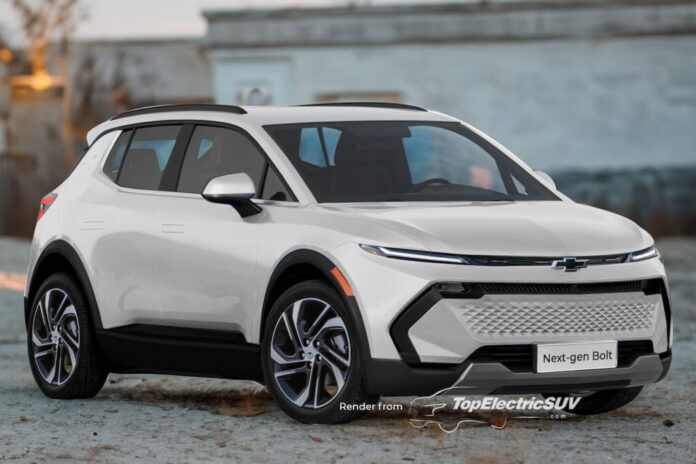The next-gen Chevrolet Bolt is expected to arrive as a 2026 model later this year. Here are the key features, aspects, and updates that we expect on what will become one of America’s cheapest electric cars.
1. Crossover Design
The next-gen Bolt will launch in a crossover body style (EUV), shifting from its earlier hatchback design. As seen in our renderings, it is expected to borrow design elements from the Chevrolet Equinox EV, including a more SUV-like appearance and split headlamps. The updated model should feature a redesigned tailgate and brake light placement for a refreshed look.
2. LFP Battery
A significant change is the introduction of LFP (Lithium Iron Phosphate) battery cells. The iron-based cells are cheaper, last longer, and handle temperature fluctuations better than traditional Lithium-ion batteries, though they have a lower energy density. We expect the new Chevy Bolt to aim for approximately 260 miles of range (EPA-est.) and offer improved charging times, with 100 miles added in just 30 minutes of DC fast charging.
3. NACS Charging Port
The next-gen Bolt will include a NACS (North American Charging Standard) port, allowing access to Tesla’s extensive Supercharger network of over 18,000 stations across North America. This addition is expected to address customer demands for a denser charging infrastructure.
4. Heat Pump Integration
One customer concern with the current Bolt EUV has been reduced range in cold weather. To address this, GM is likely to include a heat pump in the new model, improving energy efficiency during winter driving. It introduced the ‘Ultium Energy Recovery’ system on new-gen models like the Blazer and Equinox EVs, and an adaptation of the same technology is expected to feature in the 2026 Chevrolet Bolt.
5. Autonomous Robotaxi Version

GM will introduce a robotaxi based on the next-gen Bolt. This transition from the Cruise Origin platform to the Bolt platform aims to simplify scaling and regulatory compliance while taking advantage of the Bolt’s existing design and infrastructure.
6. Updated Platform
The new Bolt won’t share its underpinning with the Equinox or Blazer EVs. Instead, it will use a heavily reengineered version of the earlier BEV2 platform, incorporating modules from GM’s latest EV toolkit (formerly branded ‘Ultium’). This strategy ensures cost savings and faster development times, bringing the EV to market quickly.
7. New Infotainment System

The next-gen Bolt is expected to feature a customized Android-based infotainment system, marking GM’s shift away from Apple CarPlay and Android Auto. This in-house platform is available in models like the Blazer EV and Equinox EV, and is a generational upgrade over the system offered in the first-gen Bolt.
8. Streamlined Variant Walk
In 2023, Mary Barra, GM’s Chair & CEO, unveiled the “Winning With Simplicity” strategy, aimed at reducing trim levels, selectable options, and build combinations across product lines. For the Bolt, this means a streamlined variant lineup in the future.
However, optional features which were available on the Bolt EUV, including Super Cruise semi-autonomous driving assist, panoramic sunroof, heated/ventilated front seats, and appearance packages (like the ‘Redline’ Edition) are expected to continue in the second generation.
9. Sub-$30,000 Pricing
The next-gen Bolt will be priced slightly higher than the 2023 model, which started at $28,795 (Bolt EUV version). Mark Reuss, GM’s President, has stated that it will remain below $30,000, offering a similar value as the earlier Bolt EUV while offering upgraded features and technology. This pricing strategy should keep the Bolt competitive as one of the the most affordable electric cars in the U.S.
10. New Manufacturing Location

The Bolt’s production will shift to GM’s Fairfax Assembly plant in Kansas, which is undergoing modifications and retooling to accommodate the new model. The first-gen model was manufactured at GM’s Orion Assembly plant in Orion Township, Michigan.
Also See: 6 Affordable Electric Cars expected in the U.S. (2025-2027)
Featured image: TopElectricSUV’s rendering of the next-gen Bolt

An automobile engineer by training, I’ve analyzed the global car market since 2005, with a keen focus on EVs since 2008. My journey in online automotive publishing spans 17 years, during which I have reviewed cutting-edge automotive technologies and interviewed leading global CEOs and vehicle developers.


